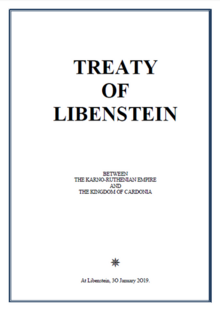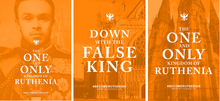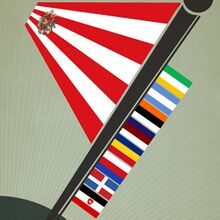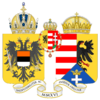Karno-Ruthenian Empire
This article or section marked as work-in-progress has not been edited in over seven days, but further work is required. Please notify the user who first added this template. |
Karno-Ruthenian Empire | |
|---|---|
| Motto: "Indivisibiliter ac Inseparabiliter" "Indivisible and Inseparable" | |
| Anthem: "God Save Emperor Oscar" | |
Location of Karnia-Ruthenia (dark green dots)within recognized macronations (light green) | |
| Capital and largest city | Persenburg |
| Official languages | English Portuguese French |
| Recognized regional languages | Greek Letzembourgish |
| Ethnic groups (2022) | |
| Religion (2018) |
|
| Demonym(s) | Karno-Ruthenian |
| Government | Corporative federative constitutional dual monarchy |
| Oscar I | |
| Dylan Callahan | |
| Legislature | Imperial Diet |
| House of Peers | |
| House of Representatives | |
| Formation | |
| 19 November 2014 | |
| 2 February 2016 | |
| 10 March 2016 | |
| 18 May 2016 | |
| 12 March 2020 | |
| 7 April 2020 | |
| 1 October 2020 | |
| 15 December 2021 | |
| Area | |
• Total | 697 km2 (269 sq mi) |
| Population | |
• 2023 estimate | 387 |
• Density | 021/km2 (54.4/sq mi) |
| GDP (PPP) | 2021 estimate |
• Total | To be calculated |
• Per capita | To be calculated |
| GDP (nominal) | 2021 estimate |
• Total | To be calculates |
• Per capita | To be calculated |
| HDI (2023) | ▲ 0.874 very high · 36th |
| Currency | Vereinsmark (RMK) |
| Time zone | UTC−3 (BRT (capital)) |
• Summer (DST) | UTC−2 (BRST (capital)) |
| Date format | dd/mm/yyyy |
| Driving side | right |
| Calling code | +55 (capital) |
| Internet TLD | .kr (de jure) |
Website karnia-ruthenia.org | |
Karnia-Ruthenia, officially The Kingdoms and Lands of the Crown of Ruthenia and the Lands Represented in the Council of Karnia (Portuguese: Os Reinos e Terras da Coroa da Rutênia e as Terras Representadas no Conselho de Kárnia), commonly referred to as the Karno-Ruthenian Empire, is a pluricontinental self-proclaimed sovereign state, widely regarded as a micronation, largely inspired by the Austro-Hungarian Empire. The Karno-Ruthenian nation is made up of several non-contiguous enclaves and exclaves in South America, North America, Europe, the Middle East, East Asia and Antarctica. Its capital and largest city, Persenburg, is entirely landlocked by Brazil. The country has a total area of 697 km² (269 sq mi) and 387 citizens spread across its vast territory and beyond. Portuguese is the language of the court, while English is the administrative language and, together with French, these are the official languages nationwide. Greek and Letzembourgish are regionally recognized languages. The Empire has a mixed government with a highly centralized semi-constitutional monarchy ruling over highly autonomous federated constituent states in real union. The Karno-Euthenian Empire is one of the most multicultural micronations in the world[citation needed], with people of multiple ethnicities, religions and nationalities exercising their citizenship.
Karnia-Ruthenia came into being from the Karno-Ruthenian Compromise of 2016, which united the crowns of the Kingdom of Ruthenia, founded independent from Brazil on 19 November 2014, the Kingdom of Horvatia, acceeded as integral part of Ruthenia through the compromise,and the Empire of Karnia, which became independent from the Czech Republic on 2 February 2016, creating a dual monarchy and a real union.[1][2][3] The emergence of the Karno-Ruthenian dual monarchy was followed by the peaceful incorporation of other micronations into the Empire, such as the kingdoms of Acrin and Cumagne and the Grand Duchies of Letzembourg, Nordinsel and Gaussland, asserting the transcontinental presence of the empire and consequently elevating it to the status of a superpower among the Brazilian-originated micronations. The Karno-Ruthenian Empire stood out as the main activist for the establishment of the secessionist Brazilian sector, as opposed to the simulationist-dominated Lusophone sector and was one of the co-founders of the Conference of Santiago. In 2023, after having incorporated famous micronations such as the North American Confederation (in the form of Occidian Empire) and the Grand Republic of Delvera, Karnia-Ruthenia became the first micronation of South American origin to participate in the MicroCon, considered[By whom?] the biggest event of world micronationalism.
Karnia-Ruthenia is a developed country according to various international standarts and has a micronational advanced emerging economy. The country's official currency is the Vereinsmark, whose value is pegged through the copper standard. Nonetheless all regional currencies of foreign states surrounding the Karno-Ruthenian enclaves are accepted as legal tenders and remains used by the resident population on a daily basis. Due to its widespread large territory for a micronation and its diplomatic relations, mostly in the form of the Emperor's personal relations, Karnia-Ruthenia can be considered a global micronational great power and the undisputed superpower within the Brazilian sector. The country is an original signatory state of many of the most important treaties of world micronationalism such as the Montediszamble Convention and the Treaty of Persenburg, in addition to have been a co-founder of the Conference of Santiago, intermicronational organization over which it exerts great influence, and one of the states involved in the revival of the Antarctic Micronational Union. The country is also one of the parties of the Pact of Malmünd, a strategic mutual-aid alliance with the kingdoms of Ebenthal and Quinta Velha, which are two of it major partners together with Lostisland, Westarctica, Pavlov and Flandrensis. Besides its Brazilian origin, the Karno-Ruthenian Empire has penetrated many other micronational sectors, being also an active member of the so-called Anglophone and the MicroWiki sectors, as well as being member in the Francophone, Czech and Artarctian sectors.
Structure and name
The monarch of the House of Götzö-Thomaz-Rocha rule as King of Ruthenia over the western and northern half of the micronation that was the Kingdom of Ruthenia ("Lands and Kingdoms of the Crown of Ruthenia", or Cismare) and the eastern half of the micronation as Emperor over the Empire of Karnia ("Lands Represented in the Imperial Council of Karnia", or Transmare). The micronation bore the official name of Karno-Ruthenian Monarchy, but it is often contracted to “Dual Monarchy” or simply referred to as “Ruthenia” or “Karnia”, but the full official name is “Lands and Kingdoms of the Crown of Ruthenia and the Lands Represented in the Council of Karnia”.
Each enjoyed considerable sovereignty with some joint affairs, principally foreign relations. The division between the two parts of Empire allows common citizenship. The Diet of Ruthenia is located in Persenburg and the Imperial Council is located in Vídeň. Both parts also use a common currency, the Ruthenian Mark. Persenburg serve as the Monarchy's primary capital.
The inspiration behind the structure and nomenclature of Karnia-Ruthenia is the Austro-Hungarian Empire, since the two projects were inspired by the Monarchy of the Habsburgs and the union could be conveniently made the same way as Austria and Hungary did when they were united in 1867.
History
Pre-Imperial Period
The Kingdom of Ruthenia was founded in 19 November 2014 by Oscar Götzö-Thomaz-Rocha. Its foundation dates back to the transfer of the Portuguese Royal Court to Brazil in 1808. The Portuguese House of Thomaz-Rocha accompained the Royal Family and arrived in Brazil, settling in the current Brazilian state of São Paulo, where they remained following the Royal Family's return to Portugal and the Brazilian independence. Upon Ruthenia was proclaimed an independent country by the heir of the House of Thomaz-Rocha, the Kingdom of Acrin became the first equally self-declared sovereign state to recognize the new country's independence. The Ruthenian Constitution was granted on 22 March 2015 and the country effectively adopted a constitutional monarchy with the King as head of state and the Chancellor as head of government under a parliamentary democratic system inspired by that of Prussia.
After solidifying, the Ruthenian kingdom, under the leadership of King Oscar I, expanded its diplomatic relations beyond the self-declared microstates of Brazilian origin. During this period the Government of the Empire of Munkkia approached the Ruthenian Government offering a union which, when rejected by the Ruthenian authorities, led to a diplomatic crisis known as "The Scandinavian Affair". Not long after, however, Ruthenia succeeded in incorporating the Duchy of Libertia and the Grand Duchy of the Savage Islands after a coup that had dethroned the Lomellinian monarch Guilherme de Lomellina-Berenguer, who was exiled to the Savage Islands and founded Libertia. Subsequently the Ruthenian Government claimed territory in Antarctica, where it founded the Grand Duchy of Gaussland.
On 22 October 2015 a Ukrainian micronationalist politician declared that he had founded a Kingdom of Ruthenia himself in 2007 and came into direct conflict with the current Ruthenian Government, which received the support of micronations such as Lostisland, Pavlov, Ruritania and Lundenwic.The following month, the government of Acrin, which until then was Ruthenia's closest ally, fell into decline after a series of unpopular measures taken by King Eitan. The Ruthenian Government tried repeatedly to contact the Acrinian Government without success, until the Acrinian Monarch replied that they would no longer take part in the actions of their government and would leave it in charge of King Oscar I of Ruthenia that he was, ex officio , the most prestigious noble of that kingdom. As a direct consequence, on 15 December 2015 Oscar deposed Eitan and the Kingdom of Acrin was annexed to Ruthenia.
Karno-Ruthenian Compromise

The Empire of Karnia was founded on 2 February 2016 in Prague by Anton Wenzel, who proclaimed it sovereign and independent from the Czech Republic. The country's governing regime was modeled after that of the Austrian Empire, however, internal conflicts undermined the development of national institutions and the country was left without a constitution, which eventually alienated members of the government. Emperor Anton I, who knew the Ruthenian Monarch, asked his help and that of his government to structure the Karnian government. The Minister-President of Karnia, Calvin Gustav, however, questioned the Monarch as to why he had acted without government knowledge or authorization, exposing the situation as an intervention by the Ruthenian government in Karnia's policies. In order to save his government, Anton I dismissed his Minister-President, appointed Louis Taünn, the President of the Reichsrat, in his place, and petitioned for a union with the Ruthenian monarchy. The result of this negotiation was the Karno-Ruthenian Compromise of 2016.
Under the terms of the Compromise, Karnia and Ruthenia would maintain separate parliaments each with its own head of government under a single monarch; a w:real union, upon which some institutions would be shared by both countries, which otherwise would remain largely independent from one another. In the Ruthenian half, the King-appointed Government would be responsible only to the Parliament instead of the King, which gave Ruthenian a great amount of autonomy, especially in internal matters. In the Karnian half, however, the Emperor would have the power to both appoint and dismiss its Minister-President and cabinet members. The Monarch's common government, in which its ministers were appointed by the Monarch direclty and responsible solely to him, held the responsibility for the armed forces, foreign policy and for the customs union. The Kingdom of Horvatia was founded in the same day of the signing of the Compromise and immediatly applied to join Ruthenia in orderto establish a union of micronations with same objectives. The founder of Horvatia, Governor and Viceroy Weslley of Agram, contacted King Oscar and confirmed the Horvatian subordination to Ruthenia in 2016 with signing of Horvatian-Ruthenian Settlement - the annex of the Compromise. By that, Horvatia became part of the Kingdom of Ruthenia in a political union and the Ruthenian Government. This gave rise to the Karno-Ruthenian Empire.
Expansion
With the establishment of the Karno-Ruthenian Empire, it assumed the position of successor state to the Kingdom of Ruthenia and Oscar I remained not only King of Ruthenia, but became King of Horvatia and Emperor of Karnia. Other states that joined Ruthenia or the Empire kept their governments intact until otherwise. The creation of this Imperial Dual Monarchy on 10 March 2016 guaranteed the country immense prestige in the then Lusophone sector, in addition to expanding the prestige that the nation enjoyed among its foreign peers. On 23 September 2016, the French-inspired Belgian-Norwergian-based Kingdom of Cumagne, founded one year earlier, was incorporated by the Karno-Ruthenian Empire and the Cumagnaise Monarchy was kept in power and with great amount of autonomy. In addition to a significant increase in the Karno-Ruthenian population, the incorporation of Cumagne enriched the Empire's cultural diversity which absorbed French elements into the union. Cumagne was soon followed by Letzembourg, a Grand Duchy established by Christian Newton in North America teh previous year and which was absorbed by Karnia-Ruthenia. The proximity between Letzenbourg and the Federal Republic of St.Charlie proved to be a decisive factor in the incorporation of the territory by the Empire, as it allowed it to approach the micronational sectors of North American origin, such as St. Charlie itself and the North American Confederation.
In 23 June 2016 the Duchy of Argadia, a former vassal state of Imvrassia within Greece, was incorporated into the Empire after weeks of negotiation involving the three countries. Appinfeldt, was the next; the Duchy enclaved within the United State was incorporated following weeks of negotiation between its respective monarchs, who were already friends. Nevertheless, Karno-Ruthenian imperialism was temporarily paralyzed. Within the Empire, the forces of opposition to the Dual Monarchy lost their disposition, leading to the creation of the Tsechian Federation on 25 December 2016, a micronation composed mostly of ethnic Czechs who refused to have Oscar I, a Brazilian of Hungarian background, as their sovereign. However, former Emperor Anton I broke a deal between the Tsechians and the Karno-Ruthenians with the establishment of the Duchy of Taschen as a nominally independent Karno-Ruthenian protectorate under the leadership of Calvin Gustav, Grand Duke of Slavonia, who formerly opposed the Karno-Ruthenian Compromise.
On 19 February 2017, the Imperial Government was surprised by a manifesto issued by the Principality of Scotia, in which the princely government requires the union of the principality to the Empire, making it a member state of Karnia-Ruthenia. The next day, the Principality of Nossia, which had been discussing a possible union for months, opted for a different output after judging that there would be much interference from the Empire in their internal affairs: it requested that the principality, instead of becoming a member-state, was transformed into a protectorate. After hours of discussion, the Imperial and Royal Council approved the union of Scotia to the Empire, but made demands about Nossia: the protectorate would last for a month and at the end of the term, or the principality would join the Empire, or would be independent again. Despite the relatively peaceful period, the principality chose to maintain its independence through a referendum held on 16 March 2017, the result of which was recognized by the Karno-Ruthenian Emperor the following day.
Nationalist uprisings
In the earlier months of 2017 a nationalistic uprising that came to be known as the Antonian Revolution broke out in Tsechia which resulted in the collapse of the Tsechian government after disagreements between the Regent and Head of State of the Tsechian Federation, Anton Wenzel and the Protector of the Tsechian Federation and Head of Government, Calvin Gustav. The revolution was first an internal affair in Tsechia, but spread after the between rebel forces loyal to the government of Calvin Gustav exposed their intention to declare independence from Karnia-Ruthenia. With little collateral damage and no change in the daily life of the Empire, Gustav's attempt to declare independence failed by sheer lack of adherence to his plans and his largely unknown figure.
On 10 October 2016, Domnitor Alexander XII of Carpathia, one of the eleven constituent states of Karnia-Ruthenia by then, informed the Government of his decision to leave the Empire. The request was accepted and made official. The Principality of Carpathia was then incorporated by the Empire of Pavlov untils its fall in 12 May 2017. From then on, Carpathia was nominally ruled by the government of Hasanistan, which included many former Pavlovians. As Karnia-Ruthenia and Pavlov became rival nations until Pavlov's fall, a law that made Pavlovians personas non gratas remained in force which caused the Hasanistani Government broke diplomatic relations with Karnia-Ruthenia. At first, the Emperor lamented the rupture of diplomatic relations, but understood the motives and would not revoke the decree. However, the Hasanistani Government reported that this was a measure to draw attention to the problem, which was harshly criticized by the Imperial Government for being an extreme measure. Since then, the Hasanistani Government, the former Domnitor of Carpathia and the Grand Duke of Letzembourg have sealed an agreement to resolve the impasse. With the connivance of Emperor Oscar, Christian of Letzembourg contacted the then Domnitor Alexander XII to reunite the principality to the Empire. The result of these negotiations is the Treaty of Gretzenmarcher, signed by both on 22 June 2017, which incorporated the Carpathia to the Empire after Alexander XII abdicate in favor of Christian of Letzembourg.
After the Reconquest of Carpathia and a strengthening of its image abroad, as well as the participation in intermicronational diplomatic events like the Micronational Republican Forum and the Congress of Colo, the prestige of the Empire led several micronations to discuss the probability of joining the Empire, but this process would be barred by the new Constitution, produced by the Constitutional Commission and approved by the Emperor on 1 August 2017. Concomitantly, there was a great flourishing of national culture and great strides towards the creation of a common nationalist sentiment, despite the differences between the regions of the Empire. This made possible the elevation of Carpathia to the status of Kingdom within the Empire and even to the succession to the throne of Horvatia, which would no longer be in personal union with the House of Götzö-Thomaz-Rocha, which in turn would also be a further departure from the terms of the Karno-Ruthenian Compromise of 2016. The House of Agram, from August 2017, instilled nationalist sentiments in the local population to force its own rise to power. Through long negotiation and good relations between the Imperial Crown ant the then Ban of Horvatia, the Agrams would ascend to the Horvatian throne. In the early morning of 3 September, Oscar I abdicated the throne in favor of Prince Joseph Cicero of Agram, father of Ban of Horvatia and head of the ducal house. Horvatia continued a country within the Empire, but the post of Ban of Horvatia was declared descontinued. With strong popular pressure to verify the progress promised through the change in the reigning house of Horvatia, King Joseph Cicero abdicated in favor of his son, Duke Weslley of Agram, 25 days after taking the throne. Unable to verify any measure that could sustain his reign, King Weslley abdicated on 3 October, having reigned for only 5 days. He resigned by returning the throne to the Emperor of Karnia-Ruthenia. After the event, the ducal family, and especially the Duke of Agram, abstained from participating in national politics, being exonerated from their posts and leaving for exile.
Internal threats and further expansion

Despite the exponential growth of the Empire, most of the threats originated from abroad. However, the greatest enemy ever faced by the Empire was a citizen. Thomas, King of Cumagne, reached the position of Imperial Chancellor. After several months of cooperation and having effectively aided the Empire, he began to resent the influence of the Duke of Libertia and aspired to violate the constitution and probably to remove the Emperor from the throne. His intentions are still unclear today, but on 24 October 2017, he was removed from the position of Chancellor after he overthrew the official forum of the Empire, leading to the loss of hundreds of government documents and hacking government emails. However, for months before that, he devised a scheme, simulating two micronations to humiliate the Emperor and incriminate him to create a false war - the Juznoslavia War. Over the next few weeks, he faked data to justify himself and defame the Emperor as a tyrant and a liar. Cumagne left the Empire, taking with him the majority of the population of Francophone origin and placing the Empire under unfounded threats, but widely diffused by third parties with shady interests. In January of the following year, the Empire regained the number of citizens that existed prior to the "Malaise", nomenclature to define the chaos that Thomas of Cumagne attempted to install in the Empire and on 23 February 2018, the trial to judge Thomas de Cumagne for more than 10 criminal conduct ended with the partial dismissal of the charges, once proven the guilt of Thomas de Cumagne. With the matter duly settled, many traces of his administration were erased, and the traitor's nickname was indelibly associated with his name.
The failed coup attempt, however, coincided with a new expansionist era in Karnia-Ruthenia. Despite recurring problems as a direct or indirect result of the Karno-Ruthenian expansion, the Imperial Government still saw advantages in its policy, such as the creation of a multicultural community. The entry into the Empire of a citizen of Japanese origin, Carl, Count Rostrand, was providential to carry out one of the greatest expansionist contracts of the history of the Empire. Although very young and with difficulties to express himself in English, Carl von Rostrand had already participated in several micronational governments in Asia. Ambitious and controversial, he tried to negotiate the establishment of a micronation to be governed by him between late 2017 and early 2018, when he finally succeeded with the creation of Hakodate as a concession territory. With the signing of the Treaty of Hakodate, the Empire now extended between the North and South America, Europe, Antarctica and, finally, Asia.
On 16 August 2018, Emperor Oscarand Michael, Duke of Solisia, as Representative of Lemurian Empire, signed the Treaty of Saint Michael of Socotra, which ensured that Lemuria would deliver the sovereignty over the Archipelago of Socotra (including Socotra Island, Abd al Kuri, Darsah and Samhah, hereinafter referred to as Socotra) with effect from 1 September 2018 and the Karno-Ruthenian Government declared that it would annex Socotra to the Empire with effect from 1 September 2018. The parties agreed to keep the terms of the treaty indefinitely, preserving the conditions that provide the signing of the treaty, stating that if the implementation of the treaty becomes infeasible to both parties, the signatories would to restore the status quo ante. The treaty also provides that Socotra would be a protectorate under imperial administration and the Karno-Ruthenian Government also declared its basic policies regarding Socotra.
Contemporary era
Beggining in 2018, with the end of Karnia-Ruthenia's 1st legislature, the country made moves towards a more democratic and less expansionist government. Wilhelm von und zu Hochbach, Palatine of the Court of Justice, wrote a new electoral law would embody the democratic tradition of the Empire, while enabling a party relationship in the political scenario at a highly professional level. It occurs that national political activity after the coup has declined. The society was accommodated with a long-term and moderate cabinet, and adherence to a party system was not exceptionally inviting, and only one political party was formed, the Patriotic Party. The Constitutional Party, the Moderate Party and the Objectivist Party were dissolved with the advent of the new law. With the absence of political parties to compete against the Patriotic Party, the July 2018 elections were postponed until the following year, when the Constitutional Party was revived and the Liberal-Democrat Party was created, which allowed the rise of a new class of politicians such as Ulli von und zu Eibenland-Sansbeurg and Thomas de Sena e Albuquerque, Margrave Karacsony.
Between 2019 and 2020 the governments of Karnia-Ruthenia, Flandrensis, Westarctica and Lostisland were in debate in order to recreate the Antarctic Micronational Union, of which all were member states and which they had previously abandoned in 2016 amid lack of cohesion and personal disputes involving other micronations. These talks materialized on 24 February 2020, when the new Charter of the Antarctic Micronational Union was signed by the representatives of Hortania, Lostisland, Užupis, Karnia-Ruthenia, Westarctica, Missionary Order of the Celtic Cross and Montescano, who reconfirmed their membership in the revived organization. The Grand Duchy of Flandrensis opted out of rejoining the AMU, but announced a change in foreign policy, recognizing the territorial claims of all AMU members.
After the resolution of the Antarctica issue, the Karno-Ruthenian government began to focus mainly on issues closer geographically, such as the fact that the Lusophone sector of micronationalism had long been dominated by simulationists who often harassed micronationalists secessionitas. Supported by close allies, Emperor Oscar launched the establishment of the Brazilian sector, a separate secessionist sector, having authored the Treaty of Persenburg. Oscar's actions, although supported by micronationalists such as Thomas I of Quinta Velha and Arthur II of Ebenthal provoked an immense negative reaction among simulationists and micronationalists who recognize simulationism and geofiction like real nations. The establishment of the Conference of Santiago, of which Karnia-Ruthenia is a founding member, was the last straw that launched the country in two years of cold war and occasional diplomatic and military conflicts primarily with the Kingdom of Manso and their simulationist allies. This led to the establishment of the Pact of Malmünd, a strategic alliance involving the Karno-Ruthenian closest allies. On the other hand, Karnia-Ruthenia's role in creating the Brazilian sector provided the country with renewed intermicronational prestige beyond continental borders, and Karnia-Ruthenia became more actively involved in the MicroWiki Sector.
On 7 August 2020, an agreement between the Empire of Karnia-Ruthenia and the North American Confederation (NAC), with the consent of the Grand Republic of Delvera has been completed to set the nation on a brand new course. That day Emperor William I signed the "Act of Abdication and Viceroyalty"[52] formally relinquishing his position as North American Emperor and appointed Emperor Oscar as his successor. Oscar has agreed to the arrangement and it was hoped that this change would enable stronger ties between the NAC, Delvera and Karnia-Ruthenia. On October 2020, the Oscarine Constitution was promulgated and reformed the NAC into the Occidian Empire. During this period from 2020 and 2021, several actions was carried in order to promote a major integration between Occidia and Delvera. On 10 June 2021, upon reception of the eloquently penned "Petition to the Delveran Nation" on 8 June 2021, a nationalistic message delivered to the Grand Republic of Delvera on their foundation day asking for the special grant of Delveran citizenship to no longer rule Occidia as a foreign monarch and to push Delvera to a more participative activity in micronational scenario, Oscar I, Occidian Emperor, became a Delveran citizen by unanimous acclamation of the Chamber of Deputies and strong popular support. When the Occidian Monarchy was bounded to Karnia-Ruthenia by personal union by August 2020, the links between Karno-Ruthenian monarchy and the Grand Republic of Delvera developed. Many Delveran citizens became Karno-Ruthenians and soon, common policies were established and the approach of the parts soon created space for negotiations for the union of the three micronations. Although not confirmed, the Treaty of Saint Theotonius signed with Eminia that merged them to the Empire may have influenced the talks to merge of the parties. Another aspect that influenced the Karno-Ruthenian government was the loss of Carpathia and Letzembourg on August 2021. By December, Delvera and Eminia joined the Empire. Technically, when Delvera joined the Empire, the union between Delvera and Occidia was dissolved, and was too united to Karnia-Ruthenia. By 2022, after the Empire left Guwati and Cardonia, the imperial government started to look more interested in America, and after negotiations, it was founded Temeswaria.
Geography
Political geography

The Karno-Ruthenian Empire consists of several constituent states, the largest of which is the Kingdom of Ruthenia. Most of these states were once independent self-proclaimed microstates who joining the Empire through treaties ranging from the establishment of personal union, real union to the commitment to submit to the Empire's suzerainty while keeping their political structures intact. These associated states have a high degree of autonomy under the terms of the Imperial Constitution, but are subject to interference of the Imperial and Royal Council and the Emperor-King himself who, despite being the direct ruler of most of the Empire's lands, has influence over the remaining regions. From 20 February 2017, after the Imperial Decree n. 078-2017 enters into force, the first protectorate of the empire, the Principality of Nossia was created. Despite the relatively peaceful period, the principality chose to maintain its independence through a referendum held on 16 March 2017, the result of which was recognized by the Emperor-King of Karnia-Ruthenia the following day.[4] The Principality of Carpathia was reunited to the Empire on 22 June 2017, following the Treaty of Gretzenmarcher and raised to the status of Kingdom on 2 August 2017. On 6 February 2018, due the Treaty of Hakodate, the Empire established the first concession of its history, the Karno-Ruthenian Concession in Hakodate, that would later be merged to Cardonia.[5] On 16 August 2018, was signed the Treaty of Saint Michael of Socotra, in which it was agreed that the Empire of Lemuria would deliver the sovereignty over Socotra to the Empire, becoming the first imperial protectorate. The Lateran State, Carpathia and Letzembourg would become independent on 2021, and Cardonia on 2022.
Geography of Ruthenia
Ruthenia possess a cultivable area of 3.8 km², already assigned to the cultivation of grain for domestic consumption and for raising cattle for slaughter and subsequent sale, in addition to the aforementioned domestic consumption. Ruthenia is bathed in a stream of clear water known in Brazil as Rio Gurguéi and Riacho das Lages, the latter known in Ruthenia as Água Branca. There is also a dam, a lake (the "Lake of Dead River" in English) and three wells, all intended for reservation and distribution of drinking water. Due to the high incidence of sunlight, plus the ability to generate hydroelectric power due to the stream that runs along the border to the north-northeast, Ruthenia also makes use of sunlight and power generators bought in Brazil. The climate is hot and humid in the northern part of the kingdom, but in the uplands it is dry with high day-time temperatures and cool nights. The South Exclave has a monsoon-influenced humid subtropical climate. In summer (January through March), the mean low temperature is about 17 °C (63 °F) and the mean high temperatures is near 28 °C (82 °F). In winter, temperatures tend to range between 11 and 23 °C (52 and 73 °F).
Government and politics
Karnia-Ruthenia is a federation of several autonomous constituent states under a parliamentary semi-constitutional monarchy. The country adopts corporatist elements and works in the framework of a real union, on which some institutions are shared among all the constituent states, which nonetheless remain largely autonomous of one another. The Emperor, commonly referred to as Emperor-King is the head of state, while the Prime Minister of Karnia occupy the position of Imperial Chancellor as head of government. leader of the Cabinet, appointing and dismissing its members. The Imperial Chancellor do not have a fixed mandate, leaving the office by resignation or motion of no confidence of the Imperial Diet. Among its competences, are exercise the highest authority in matters concerning the Government, head the Cabinet, appoint and dismiss the members of the Cabinet, upon the consent of the Emperor, advise and be advised by the Emperor, create and regulate imperial agencies, propose bills to the Imperial Diet, monthly take part in the Imperial Diet, in Ordinary Session, to answer the Questions to the Imperial Chancellor.
As per the Karno-Ruthenian Compromise of 2016, the Kingdom of Ruthenia and the Empire of Karnia maintained separate governments, each with its own parliament and head of government, under the central Imperial and Royal Government which governed the countries' foreign and financial policy in union. With the promulgation of the Imperial Constitution of 2017, the parliaments were unified into one, the Imperial Diet, a bicameral parliament with representatives of all the regions of the Empire. In accordance with article 80, Chapter V of the Constitution, the Imperial Diet is the political body with the highest authority in government, responsible for administering legislative power, and it is divided into an upper chamber, the House of Peers, and a lower chamber, the House of Representatives. The competences of the Imperial Diet are: authorize the declaration of war and the celebration of peace, override State of Exception declaration, authorize the ratification of international treaties, authorize the resignation of the Emperor and recognize the Crown Prince, authorize the marriage of the Emperor and the Crown Prince, supervise the activities of the Cabinet, give effect to motion of no confidence, elect by relative majority the Imperial Chancellor and enact constitutional amendments.
The government comprises ministers for joint responsibilities (culture, finances, foreign affairs, immigration, imperial and royal household, information, internal affairs and defense)[6] In June 2016, two ministries were created: the Ministry of Strategic Affairs, responsible for the development of new approaches from the Imperial and Royal Government to its citizens and foreigners and the Ministry of Antarctic Affairs, to protect, defend and clarify the situation of the Antarctic continent and specially the current status of the Grand Duchy of Gaussland. The last ministry created was of the Ministry of Justice, on 9 December 2016, related to the Imperial Supreme Court. This structure was maintained after the promulgation of the new constitution.
Law
At the beginning of Ruthenian history, which is the origin of the Empire itself and the state with the most profound legal tradition, did not have a single legal system, considering the use of common-law principles. However, when the General Assembly of the Kingdom was established, the development of more specific laws such as the Civil Code, eventually forced the creation of a different legal system of the intended previously. Therefore, extensive legislation was created between the years 2014 and 2016 until the signing of the Karno-Ruthenian Compromise of 2016.
Since the states of the Empire were formed in a large majority of new micronations, most of the legislation would be coming from the proper legislative process of the Empire, which largely was the Ruthenian legislation adapted to this new situation. In 2016, after the Foundation of the Empire, the common Criminal Code and a Civil Code, adapted of Ruthenian versions of 2015 was introduced after the consolidation of the Constitution over all other constitutions of the states that composed the Empire. The legal culture of the Empire has always been very rich, but has become much improved over time, especially after the completion of the work of the Constitutional Commission and the promulgation of the new constitution.
Internal Affairs
The Karno-Ruthenian Compromise of 2016 created the semi-independent states of Ruthenia and Karnia linked by personal union under a common monarch, establishing a constitutional monarchy with a system of corporative federalism, a system of federalism not based on the common federalist idea of relative land area or nearest spheres of influence for governance, but on fiduciary jurisdiction to corporate personhood, where groups who are considered incorporated members of their own prerogative structure by willed agreement can delegate their individual effective legislature within the overall government. This system is similar to that used by the Austro-Hungarian Empire, a version of corporative federalism that gave its wide demographic of different ethnicities each their own individual rights within their own assemblies instead of by relation to the territory of the Empire.
The Imperial Constitution of 2017, the third in force throughout Karno-Ruthenian history, ensured numerous new rights to the population, like a more representative and less confused democracy through a unified parliament, the Imperial Diet. Making the state leaner and more efficient was one of the commission's biggest challenges, which made the Empire a unitary and cohesive state. This made the Empire more distant from the Austro-Hungarian model chosen at first, which made the state structure more like a modern state.

Foreign Affairs
The foreign relations of the Empire are implemented by the Ministry of Foreign Affairs. The Emperor-King and the prime ministers of each part of the Empire play a role in setting policy, and the Minister of Foreign Affairs have a voice and are the one who develop this policy. Since its founding, the Kingdom of Ruthenia and after the Karno-Ruthenian Compromise of 2016, the Karno-Ruthenian Empire and its government pays special attention to foreign affairs. One of the first ministries of government was precisely the Ministry of Foreign Affairs, which was founded on the same day that the kingdom, on 19 November 2014. Diplomatic relations are conducted by the Minister of Foreign Affairs, but the leadership of Foreign Affairs is in practice, led by His Imperial and Royal Majesty, the Emperor-King. Karnia-Ruthenia monthly studies and develops diplomatic relations with several micronations around the world, maintaining cordial relations with everyone and accounting for only four international incidents, only two of whom suffered from more serious action by the government.
Military
The military system of Karnia-Ruthenia, based upon the principle of the universal and personal obligation of the citizen to protect his homeland. Its military force was composed of the Imperial and Royal Army, a Imperial and Royal Navy and a Imperial and Royal Aviation Troops. The common army is under the administration of the joint Minister of War. The common Minister of War was the head for the administration of all military affairs and for all questions related to national defence of the states members of the Empire, but the supreme command of the army is vested in the monarch, who had the power to take all measures regarding the whole army and Commander-in-Chief. The Navy is mainly a defence force dedicated to the protection of Karno-Ruthenian interests in Gurguéia River, a river which is the natural border of the Principality of St. Peter and St. Paul and crosses the Principality of St. Stephen, which also forms the Lake of Dead River (Lago do Rio Morto, in Portuguese).
Demographics
Language
In everyday use, Portuguese is used by the majority of the subjects in Ruthenia, Libertia and Horvatia. In Court, the official language while still the Portuguese, the English and French has also regular use, especially by the government and it is the only language used by the Ministry of Foreign Affairs. But English is the official language after a plebiscite to decide which national language would be adopted by Ruthenia. Lusophones and Anglophones had split the Ruthenian government, disputing for power. The plebiscite ended with the victory of the supporters of the English language. With the formation of the Empire and the subsequent constitutional reform, English and Portuguese became the official languages of the micronation. The States of the Empire can edit legislation and make use of the Portuguese for their affairs, but in common subjects, only English is allowed. In some regions, French is also spoken among the population and in domestic affairs.
Religion

Since the founding of the Kingdom of Ruthenia, religious freedom is guaranteed by law to all subjects.[7] This guarantee was reassured in the Ruthenian Constitution of 2015 and in the Imperial Constitution of 2016. Due to cultural and social diversity of the Empire, the Roman Catholicism is predominant and is even the official religion of the Empire, according to the constitution. But the Unitarianism, Deism and Eastern Orthodoxy still enjoy official status. The Patron Saint of the Empire is St. Stephen, King of Hungary, also the patron saint of the Imperial and Royal Family. His cult acquire more strength when genealogical studies showed a kinship between the Imperial and Royal Family with King Ladislaus I of Hungary through Mary of Hungary, wife of Iaroslav Sviatopolchich of Volhinia and also a distant relative of St. Stephen. St. Stephen's feast is observed on 16 August, one of the most important holidays of the Empire. In Karnia, the patron saint is St. Adalbert of Prague and in Libertia, Leonardo da Vinci was made a kind of "patron saint", an example to be followed in the duchy which is Deist.
Culture
The Karno-Ruthenian culture retains much of the European influence originally brought by the Imperial and Royal Family and the rulers of the states of the Empire. It places an important emphasis on family, religion, and traditions in general, such as respect for holy days. In Ruthenia, music consists mainly of traditional Hungarian folk music, especially the Csárdás, and music by prominent composers such as Béla Bartók, Vittorio Monti, Pyotr Ilyich Tchaikovsky and Georges Bizet, and also makes success the current pop songs. Other aspects of Ruthenian culture include Horse racing, Hunting (banned by the Royal Family since 2014), Masses on Sundays for the Catholics, and festivals between June and August dedicated to St. Anthony and St. John the Baptist, among others, where dancing around bonfires takes place.
The culture is also largely influenced by the Lomellinian Culture, adopting most of the Lomellinian traditions and customs as well as certain similarities with the Portuguese culture and Italian culture. These two great European influences made, especially of Libertian culture, a romantic and flattering influence in the micronational world. In Libertia, is usual for a citizen say they have three main goals: Discover, considering that since the beginning, the Libertian ancestors dedicated their lives into discovering new lands and new ways of living; so, Libertians follow their actions into discovering new ways to improve it's citizen's lives. Create, the best works of art always inspired the best minds of mankind into re-writing history as we know today, Libertians create those inspiring pieces to allow tehir citizens to improve and Preserve, the world's biggest archives helped the people understand their ancestors into improving what was already done, Libertians preserve that information, allowing the common citizen to learn more. Libertians, mainly the Grancasian people practice somekind of artform wich is one of the greater values of the duchy, the ducal family is often seen painting, composing, decorating and even writing pieces of art.
Other cultures that influenced the Empire everyday are the Croatian culture brought by Horvatians and the Irish culture from Kingdom of Acrin. After the Compromise that united the Empire, these cultures began an exchange with each other, mixing tastes and habits, greatly enriched by Germanic cultural aspects brought by Karnia and Letzembourg. After the Treaty of Nison in September 2016, many French elements were observed in society and were introduced by the Cumagnaise.
National colors and symbols
-
Civil Flag
-
State Flag
-
Imperial Eagle
-
Greater Coat of Arms
-
Medium Coat of Arms
Cuisine

With variety as diverse as its society, eating habits suffer direct influence of European cuisine. The Ruthenian cuisine is marked by the conspicuous use of meat in many of its traditional dishes. Typically, Ruthenians feed on rice accompanied by beans, quite varied green salad, and meat and eggs. A popular dish is the barbecue, especially beef, served with sauces or with French bread. In Persenburg, popular dishes include lasagna, pizza, pancakes, and also the consumption of sweets such as cakes and pies, all inspired by the European habits of the inhabitants of the capital. In Libertia, the national food is the Lasanha de Peixe (English: Fish Lasagna) mixing the Lasagna from the Italian culture and the fish element from the Portuguese culture. It is one of the most cherished dishes in Grancasa and is often in celebratory days, mainly Christmas and Court dinners. Other traditional dishes are Bacalhau (Cod Fish), Canelones (Cannelloni) and all types of pasta and sauces.
National holidays
The national holidays are of paramount importance in order to inspire the Karno-Ruthenian people to celebrate their unique and extremely rich culture and exist holidays with fixed and with varying dates. National holidays were regulated by Imperial Decree 028-2016[8] and other specific laws.
| Name | Date | Notes |
|---|---|---|
| New Year's Day | 1 January | The first day of the Gregorian year. |
| Libertian Day | 30 January | Commemoration of the merger of the Duchy of Libertia to the Kingdom of Ruthenia. |
| Constitution Day | 6 February | Commemoration of the first constitution. |
| Archduke Ari's birthday | 3 March | Anniversary of His Imperial and Royal Highness, the Archduke and former King of Ruthenia. |
| International Women's Day | 8 March | Celebration of respect, appreciation, and love towards women. |
| Dual Monarchy Day | 10 March | Celebration of the signature of the Karno-Ruthenian Compromise of 2016. |
| Easter Day | Between 22 March and 25 April | Celebrates the resurrection of Jesus. |
| International Workers' Day | 1 May | Honors the contributions that workers have made to the strength, prosperity, and well-being of the country. |
| Corpus Christi | Between 21 May and 24 June | Solemnity which honors the Body of Christ. |
| National Flag Day | 26 May | Celebration of the establishment of the national symbols of Karnia-Ruthenia. |
| Lover's Day | 12 June | The day before Saint Anthony's day, known as the “patron saint of marriages”. Karno-Ruthenian version of Valentine's Day. Traditional start of the June Festival. |
| Archduchess Denise's birthday | 16 June | Anniversary of Her Imperial and Royal Highness, the Archduchess and former Queen of Ruthenia. |
| Antarctic Day | 30 June | Celebrate the annexation of the Grand Duchy of Gaussland. |
| Martyr's Day | 17 July | Tribute to Royal Passion-Bearers Nicholas II of Russia and his family, as well as all other victims of Communism. |
| Empire Day | 1-5 August | Annual celebration of the Empire's foundation and of the culture of the states of the Empire. |
| Emperor-King's Day | 14 August | Anniversary of His Imperial and Royal Majesty, the Emperor-King. |
| St Stephen's Day | 16 August | Tribute to the patron saint of the Empire and of Ruthenia and their Imperial and Royal Family; Hungary's first king St. Stephen's Day, also the day of the Foundation of Hungary. |
| Children's Day | 12 October | Honor children, promote mutual exchange and understanding among children and initiate actions to benefit and promote the welfare of the world's children. |
| Teacher's Day | 15 October | Special day for the appreciation of teachers and their special contributions to the society. |
| All Saints’ Day | 1 November | In honour of all the saints, known and unknown; Roman Catholicism. |
| All Souls’ Day | 2 November | Commemorates the faithful departed. |
| Armistice Day | 11 November | Commemoration of the armistice signed between the Allies of World War I and Germany and also in commemoration of both living and dead soldiers who served in any conflict. |
| Foundation Day | 19 November | Foundation of the Kingdom of Ruthenia, the predecessor State of the Empire. |
| Christmas Day | 25 December | Traditional commemoration of the birth of Jesus. |
| New Year's Eve | 31 December | The final day of the Gregorian year; Saint Sylvester's Day. |
External links
- Official website
- Official Facebook page
- Official Forum
- Government Twitter account
- Official Youtube channel
- Ruthenian Observer website
- Libertian Archives website
References
- ↑ "Lundenwic Gazette" no. 03, 31 March 2016.
- ↑ "The Ruthenian Observer" no. 64, 16 March 2016.
- ↑ "Big March Announcement" by the Emperor-King, 10 March 2016.
- ↑ Imperial Decree n. 082-2017, that restores the independence of Nossia and other provisions. 17 March 2017.
- ↑ "TREATY OF HAKODATE SIGNED; THE EMPIRE EXPANDS!", Imperial and Royal Government, 06 February 2018.
- ↑ Imperial and Royal Decree n. 009/2016, about the establishment of the ministries of His Imperial and Royal Majesty's Government, 26 April 2016.
- ↑ Royal Decree nº 001-012
- ↑ Imperial Decree n. 028-2016, about the national holidays.




















